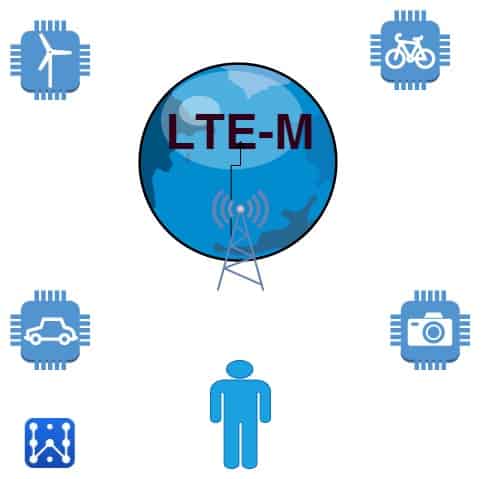summarize
eMTC (enhanced Machine-Type Communication), also known as LTE-M (LTE-Machine-to-Machine Long Term Evolution-Machine-to-Machine), is an LTE technology between machines. LTE-M is a Low Power Wide Area (LPWA) technology. wireless interfaceThis technology supports the connection of IoT and M2M devices with medium data rate requirements. The technology enables longer range and wider in-building coverage than standard cellular technologies such as 2G, 3G or higher LTE

histories
Generation of LTE technology
LTE technology was developed by3GPP(The long-term evolution of the UMTS (Universal Mobile Telecommunications System) technical standard developed by The 3rd Generation Partnership Project (3GPP) was formally established and launched at the 3GPP Toronto meeting in December 2004, with the launch of the project. Toronto meeting to formally establish and launch the project. WithNB-IoTThe same agency is responsible for its development.
The technical objectives of LTE can be summarized as
- Capacity enhancement: under 20MHz bandwidth, the downlink peak rate reaches 100Mbit/s, and the uplink peak rate reaches 50Mbit/s. The spectrum utilization rate reaches 2-4 times of the 3GPP R6 planning value;
- Coverage Enhancement: Increase the "cell edge bit rate" to meet the optimal capacity in the 5km area, with a slight decrease in the 30km area, and support a coverage radius of 100km;
- Improved mobility: optimal performance from 0 to 15km/h, high performance from 15 to 120km/h, and support for 120 to 350km/h. Even support for 500km/h in some frequency bands;
- Quality optimization: less than 10ms delay in the RAN user plane and less than 100ms delay in the control plane:
- Comprehensive and diversified service content: Provides high-performance MBMS for broadcast services, improves real-time service support capability, and enables VoIP to reach UTRAN circuit domain performance.
- Reduced O&M costs: the adoption of a flat architecture reduces CAPEX and 0PEX, and reduces the cost of evolving from R6 UTRA airports and network architectures
Definition of LTE Cat
Cat is the meaning of Category, LTE CAT full name LTEUE-Category, split to explain: LTE refers to the 4GLTE network, UE refers to the user equipment, Category translated into rank. Smooth explanation is that the user equipment can support the 4GLTE network transmission rate level, can also be said to be a technical standard for 4G network speed.

Attention:
- The maximum data rates shown apply to a 20 MHz channel bandwidth. Categories 6 and above include data rates for combining multiple 20 MHz channels using carrier aggregation. If less bandwidth is used, the maximum data rate will be lower.
- These are L1 transmission data rates, excluding the different protocol layer overheads. The actual data rates will vary depending on cell bandwidth, cell load, network configuration, performance of the UE used, propagation conditions, etc.
- The 3.0 Gbit/s /1.5 Gbit/s data rate assigned to category 8 is close to the peak aggregated data rate of the base station sector. More realistic maximum data rates for a single user are 1.2 Gbit/s (downlink) and 600 Mbit/s (uplink). One vendor has demonstrated downlink speeds of 1.4 Gbit/s using 100 MHz of aggregated spectrum.
The evolution of LTE-M
LTE-M (eMTC) was originally introduced as LTE Cat M1 in the 3GPP 13th Edition standard, which also defines Narrowband IoT (NB-IoT or LTE Cat NB1, both of which are LPWA technologies in licensed spectrum). 3GPP 14th Edition developed the LTE Cat M2 standard. LTE Cat M1 transmits data at a bandwidth of LTE Cat M1 transmits data at a bandwidth of 1.4 MHz, while LTE Cat M2 will increase to 5 MHz. the standard will bring improvements in several areas
- data transmission rateLTE Cat M1 can support uplink and downlink speeds of 375 kb/s in half-duplex mode, making it ideal for many IoT applications with low to medium data rate requirements. LTE Cat M2 will increase data throughput to a peak download rate of 2.4 Mb/s and a peak upload rate of 2.6 Mb/s, broadening LTE-M's appeal even for relatively high data rate applications such as video surveillance. appeal, even for applications with relatively high data rates such as video surveillance.
- mobility: Compared to NB-IoT, LTE-M is ideal for mobile use cases because it handles switching between base stations just like high-speed LTE. For example, if a vehicle is traveling from point A to point B and needs to cross a number of different network units, the LTE-M device will behave like a cellular phone and never disconnect. Instead, the NB-IoT device must re-establish a new connection at some point after reaching the new network unit. LTE-M Release 14 now offers several advantages over the mobile features already supported in LTE-M Release 13, including low power consumption and full mobility (intra- and inter-frequency) for mobile applications
Technical characteristics
LTE-M has several advantages over NB-IoT technology
- High-speed rate: can support upstream and downstream maximum 1Mb/s peak rate, to ensure coverage and low power consumption, can do low-speed video and voice applications
- Mobility: NB-IoT is less mobile and does not support switching, so it is used in areas that generally do not need to move, water meters, electricity meters, street lights and such products, while LTE-M can be used in vehicles or wearable devices such as smart watches
- Positioning is possible: LTE-M based on TDD (TimeDivision Duplex) allows PRS (positioning reference signal) measurements to be made using the base station. Positioning is possible without a GPS signal.
- Support voice: support VoLTE, can be used for emergency call related IoT applications
- Supports LTE network multiplexing, directly based on the existing LTE network for upgrading and deployment, and the existing LTE base station shared antenna, reducing costs
LTE-M versusNB-IoTtechnology, its coverage and cost are at a disadvantage, so if you need to use NB-IoT in the case of wide coverage; and for the cost requirements are not high, there is a need to move the occasion, and the transmission of a slightly larger amount of data, the use of LTE-M
Main application areas
- Automotive and Transportation: LTE-M supports full handover between network elements in moving vehicles, making it suitable for mobile use cases with moderate data rate requirements, including vehicle tracking, asset tracking, Telematics, fleet management and usage-based insurance.
- Smart Metering: LTE-M is also ideal for monitoring and controlling meters and utility applications through regular and small amounts of data transmission. Network coverage is a key issue in the rollout of smart metering. Since meters are often located in buildings or basements, LTE-M's wider coverage allows for better coverage in harsh environments.
- Smart Buildings: With enhanced indoor coverage, LTE-M makes it easy to provide basic building management functions, including HVAC, lighting and access control. With VoLTE voice support, LTE-M is also ideal for critical applications such as security systems and alarm panels.
- Connected Healthcare Devices: LTE-M is also an ideal wireless interface for connected healthcare device applications such as outpatient monitoring and retention solutions, due to its wider in-building coverage, voice support capabilities and mobility.
- Smart Cities: In smart cities, LTE-M meets every type of need and can efficiently control street lighting in milliseconds, determine when garbage garbage cans need to be emptied, identify available parking spaces, monitor environmental conditions, and survey road conditions.

LTE-M supplier
- Telit
- u-blox
- Laird
- AT&T
- Cavli Wireless
- Cheerzing TiJun IOT
- H3C Xinhua Sanhua (Chinese company)
- Fibocom Guanghetong (brand)
- HuaweiHathi (Japanese company)
- KDDI
- LinkLabs
- LongsungLungsang, capital of China (Tw)
- MeigMegha
- Mobiletek
- Multitech
- MuRata
- Neowayuse the correct method
- NimbeLink
- Nordic Semiconductor
- pycom
- Quectelchange a distance
- SERCOMM
Content review.





